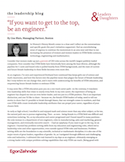“If You Want to Get to the Top, Be an Engineer.”
As Women’s History Month comes to a close and I reflect on the conversations and specific goals this year’s initiatives supported, I feel an overwhelming sense of urgency to continue the momentum in an area near and dear to me: increasing the presence of women and women leaders in STEM fields (sciences, technology, engineering and mathematics).
Consider that women make up just 4 percent of CEO roles across the world’s largest publicly traded companies. Now consider that STEM fields have historically been among the least diverse, although the pipeline for C-suite and board roles is pulled heavily from STEM backgrounds, and the state of current and future female leadership in these fields becomes even more dire.
As an engineer, I’ve seen and experienced firsthand how continued bias keeps girls out of science and math classrooms, and how this factors into the pipeline issues that plague the future of female leadership. But I truly believe we can change that, and it starts with underscoring the benefits of STEM education, and empowering future female leaders to embrace STEM.
It may seem like a STEM education puts you on a one-track career path– on the contrary, it translates into leadership skills that relate to nearly every field. In my own career, the experience of being an engineer has shaped me into an even better leader, and not just in a STEM position. This is an important distinction, and one I’d like to share – because we, the female STEM leaders of today, need to tell our stories to show that it’s possible to break through biases, that our strength comes in numbers, and that core STEM skills create invaluable leadership attributes that can propel your career, regardless of your chosen field.
As early as high school, I excelled in and enjoyed math and science more than any other subject, so for me, the natural path was to pursue engineering. Then – as now – being female in a STEM field was difficult and sometimes isolating. Yet, as my education and career progressed and I found myself in many positions – the only woman in a department of 200 engineers, roles in manufacturing, sales and marketing, general management, and eventually executive search – I had an epiphany: If you want to get to the top, be an engineer. I learned key problem-solving skills from my education and engineering roles, which led to leadership roles and other opportunities, even outside typical STEM roles and businesses. Problem-solving skills are the foundation to any scientific, technical or mathematic discipline; it is also one of the major tenets of great leaders, regardless of gender. So, as I navigated through different and challenging roles and industries, I cultivated this trait learned in my days as an engineer, ultimately emerging as a strong leader with unique problem-solving capabilities that only STEM can teach. (Being good with people didn’t hurt, either). And little did I know then how important this engineering background would become in a world that has been flipped upside down by technology.
Of course, I was certainly not immune to the societal stigmas that can often hold women back from pursuing STEM careers. It’s all still very much present – from the outdated and uninformed insults about women being “bad at math,” to objectification in consumer technology apps and services contributing to the commodification of women, to society’s expectation that women’s careers take a back seat to men’s in order to take primary responsibility for child-rearing. The discriminatory culture still exists from childhood through to one’s career.
Thankfully, corporations of all sizes around the world are making a concerted effort to combat these stigmas in order to encourage women into STEM careers. Some companies have instituted goals for more diverse workplaces. Others are running public awareness campaigns promoting how much girls can achieve from education to professional life within STEM – like Microsoft’s campaign #MakeWhatsNext, which explores the issues that cause girls to drop out of or lose interest in science, technology, engineering and math. State Street erected a small but powerful Fearless Girl statue to further the global discussion of gender diversity in finance, and Egon Zehnder drove 40 Leaders & Daughters panels around the world as a direct and personal call to action to have conversations about the opportunities and ambitions of next-generation female leaders.
These efforts can have a huge impact on both the culture and the practices that continue to keep women out of STEM and leadership roles. And as research has shown, a rising tide floats all boats: the more women we can get into these fields, the stronger our voices will be, and the more influential we’ll become. All STEM-related industries can and will benefit from the power that diverse mindsets can have on innovation.
Support and recognition across the spectrum, from executive leaders to school programs, will help us build not only a stronger female STEM pipeline, but also a stronger female leadership pipeline. And I’m just one of many examples of this. STEM undoubtedly accelerated my career, and I believe these core principles are the foundation for leadership in any field. There is great momentum built already, but we need to do more to avoid inertia. Let’s use the conversations of the past month and stories from female STEM leaders to encourage the next generation to rewrite the rules, every month of the year.






